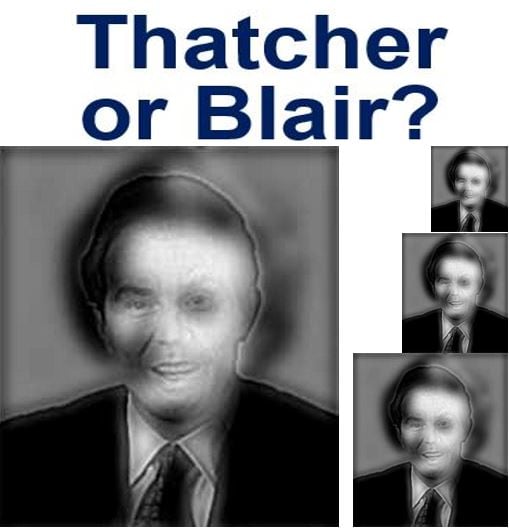If you mix images of Tony Blair with Margaret Thatcher or Albert Einstein with Marilyn Monroe, combining low spatial frequency components of one with high spatial frequency components of the other, and then look at different sizes of the combined images, you will know whether you have eyesight problems and need glasses.
In the two sets of images below, in the small ones you should start seeing Marilyn Monroe or Margaret Thatcher, as the pictures grow they should gradually change to the UK’s ex male prime minister or the physics genius, that is, if you have perfect eyesight.
If you continue seeing the woman, go and get your eyes tested, you either need to wear glasses or should get your current ones altered.

The small image of Margaret Thatcher should gradually turn into one of Tony Blair as your eyes move to the larger photos. (Image: MIT)
The same applies to how close or far away you are from a hybrid image. If you stand far away in either case you will see the female (Monroe or Thatcher), and as you get closer the picture will gradually turn into the male (Einstein or Blair), again, if your vision is good.
What is a hybrid image?
A hybrid image is one that is perceived in one of two different ways, depending on its size or viewing distance – it is an optical illusion.
A technique for creating hybrid images exhibiting this optical illusion was developed by Philippe G. Schyns of the University of Glasgow in Scotland, and Aude Oliva of MIT in the US – a method they proposed in 1994.
Dr. Oliva wrote about hybrid images in the journal Art & Perception in 2013.
Dr. Oliva said:
“The phenomenon of hybrid images arises from the multi-scale processing of images in the human visual system.”
“By taking into account perceptual grouping mechanisms, one can build compelling hybrid images with two different stable interpretations: one that appears when the image is viewed up-close, and the other that appears from afar.”
“Hybrid images can be used to create compelling prints and photographs in which the observer experiences different percepts when interacting with the image.”
Dr. Oliva, who works as a Principal Research Scientist at the Computer Vision & Graphics Group at MIT, has spent more than ten years creating hybrid optical illusions.

If your eyesight is perfect, the smallest image should look more like Marilyn Monroe and the largest like Albert Einstein. (Image: MIT)
AsapScience explains hybrid images
AsapScience, a video YouTube channel created by Gregory Brown and Mitchell Moffit, highlighted the processes behind hybrid images.
The two Canadian presenters explained:
“Depending on how well you’re able to focus or pick up contrast your eye will only pick out details. Up close, we’re generally able to pick up fine details like Einstein’s moustache and wrinkles.”
“But as the distance increases, or if your vision is poor and creates a more blurred image in the first place, your ability to pick up details fades away. Instead you only see general features, like the shape of mouth, nose and hair, and are left seeing Marilyn Monroe.”
Video – Hybrid images
